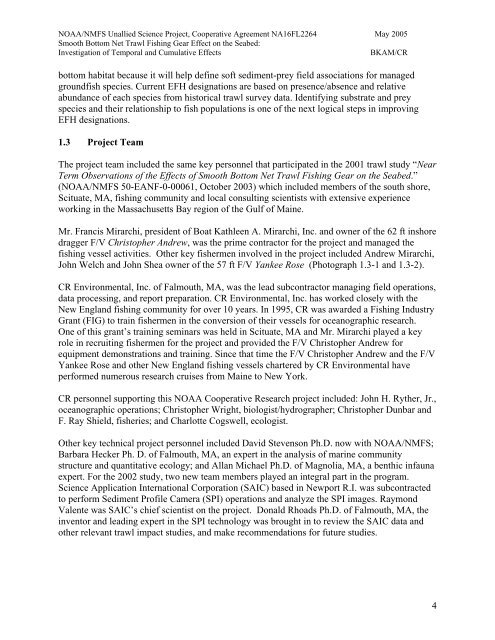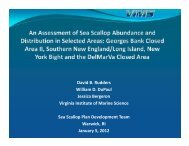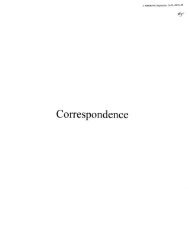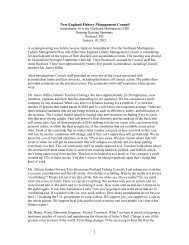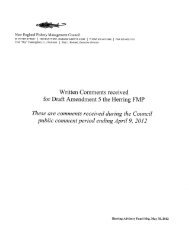Smooth Bottom Net Trawl Fishing Gear Effect on - New England ...
Smooth Bottom Net Trawl Fishing Gear Effect on - New England ...
Smooth Bottom Net Trawl Fishing Gear Effect on - New England ...
Create successful ePaper yourself
Turn your PDF publications into a flip-book with our unique Google optimized e-Paper software.
NOAA/NMFS Unallied Science Project, Cooperative Agreement NA16FL2264 May 2005<br />
<str<strong>on</strong>g>Smooth</str<strong>on</strong>g> <str<strong>on</strong>g>Bottom</str<strong>on</strong>g> <str<strong>on</strong>g>Net</str<strong>on</strong>g> <str<strong>on</strong>g>Trawl</str<strong>on</strong>g> <str<strong>on</strong>g>Fishing</str<strong>on</strong>g> <str<strong>on</strong>g>Gear</str<strong>on</strong>g> <str<strong>on</strong>g>Effect</str<strong>on</strong>g> <strong>on</strong> the Seabed:<br />
Investigati<strong>on</strong> of Temporal and Cumulative <str<strong>on</strong>g>Effect</str<strong>on</strong>g>s BKAM/CR<br />
bottom habitat because it will help define soft sediment-prey field associati<strong>on</strong>s for managed<br />
groundfish species. Current EFH designati<strong>on</strong>s are based <strong>on</strong> presence/absence and relative<br />
abundance of each species from historical trawl survey data. Identifying substrate and prey<br />
species and their relati<strong>on</strong>ship to fish populati<strong>on</strong>s is <strong>on</strong>e of the next logical steps in improving<br />
EFH designati<strong>on</strong>s.<br />
1.3 Project Team<br />
The project team included the same key pers<strong>on</strong>nel that participated in the 2001 trawl study “Near<br />
Term Observati<strong>on</strong>s of the <str<strong>on</strong>g>Effect</str<strong>on</strong>g>s of <str<strong>on</strong>g>Smooth</str<strong>on</strong>g> <str<strong>on</strong>g>Bottom</str<strong>on</strong>g> <str<strong>on</strong>g>Net</str<strong>on</strong>g> <str<strong>on</strong>g>Trawl</str<strong>on</strong>g> <str<strong>on</strong>g>Fishing</str<strong>on</strong>g> <str<strong>on</strong>g>Gear</str<strong>on</strong>g> <strong>on</strong> the Seabed.”<br />
(NOAA/NMFS 50-EANF-0-00061, October 2003) which included members of the south shore,<br />
Scituate, MA, fishing community and local c<strong>on</strong>sulting scientists with extensive experience<br />
working in the Massachusetts Bay regi<strong>on</strong> of the Gulf of Maine.<br />
Mr. Francis Mirarchi, president of Boat Kathleen A. Mirarchi, Inc. and owner of the 62 ft inshore<br />
dragger F/V Christopher Andrew, was the prime c<strong>on</strong>tractor for the project and managed the<br />
fishing vessel activities. Other key fishermen involved in the project included Andrew Mirarchi,<br />
John Welch and John Shea owner of the 57 ft F/V Yankee Rose (Photograph 1.3-1 and 1.3-2).<br />
CR Envir<strong>on</strong>mental, Inc. of Falmouth, MA, was the lead subc<strong>on</strong>tractor managing field operati<strong>on</strong>s,<br />
data processing, and report preparati<strong>on</strong>. CR Envir<strong>on</strong>mental, Inc. has worked closely with the<br />
<strong>New</strong> <strong>England</strong> fishing community for over 10 years. In 1995, CR was awarded a <str<strong>on</strong>g>Fishing</str<strong>on</strong>g> Industry<br />
Grant (FIG) to train fishermen in the c<strong>on</strong>versi<strong>on</strong> of their vessels for oceanographic research.<br />
One of this grant’s training seminars was held in Scituate, MA and Mr. Mirarchi played a key<br />
role in recruiting fishermen for the project and provided the F/V Christopher Andrew for<br />
equipment dem<strong>on</strong>strati<strong>on</strong>s and training. Since that time the F/V Christopher Andrew and the F/V<br />
Yankee Rose and other <strong>New</strong> <strong>England</strong> fishing vessels chartered by CR Envir<strong>on</strong>mental have<br />
performed numerous research cruises from Maine to <strong>New</strong> York.<br />
CR pers<strong>on</strong>nel supporting this NOAA Cooperative Research project included: John H. Ryther, Jr.,<br />
oceanographic operati<strong>on</strong>s; Christopher Wright, biologist/hydrographer; Christopher Dunbar and<br />
F. Ray Shield, fisheries; and Charlotte Cogswell, ecologist.<br />
Other key technical project pers<strong>on</strong>nel included David Stevens<strong>on</strong> Ph.D. now with NOAA/NMFS;<br />
Barbara Hecker Ph. D. of Falmouth, MA, an expert in the analysis of marine community<br />
structure and quantitative ecology; and Allan Michael Ph.D. of Magnolia, MA, a benthic infauna<br />
expert. For the 2002 study, two new team members played an integral part in the program.<br />
Science Applicati<strong>on</strong> Internati<strong>on</strong>al Corporati<strong>on</strong> (SAIC) based in <strong>New</strong>port R.I. was subc<strong>on</strong>tracted<br />
to perform Sediment Profile Camera (SPI) operati<strong>on</strong>s and analyze the SPI images. Raym<strong>on</strong>d<br />
Valente was SAIC’s chief scientist <strong>on</strong> the project. D<strong>on</strong>ald Rhoads Ph.D. of Falmouth, MA, the<br />
inventor and leading expert in the SPI technology was brought in to review the SAIC data and<br />
other relevant trawl impact studies, and make recommendati<strong>on</strong>s for future studies.<br />
4


